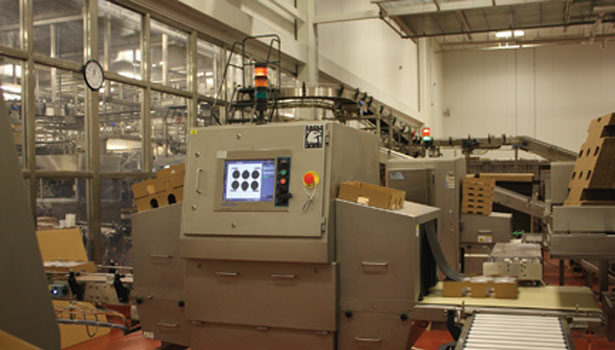X-ray technology is best when SS foreign objects need to be detected in products that are conductive, according to Spurgeon. He attributes this to the physics of the application. For example, SS is masked when scanned by a metal detector because conductive products and SS “look” the same to a metal detector. An X-ray system, however, uses contrast (which is not affected by the conductivity of products) to detect SS targets. But, if a product is dry, non-homogenous (e.g., a box of rigatoni pasta) and has no foil packaging or safety seals, a metal detector will consistently outperform an X-ray system, says Spurgeon.
The Anristu X-ray system, according to Young, can typically find 0.8mm SS in most food products (both reactive and non-reactive). On thinner products, detection down to 0.4mm SS is possible, and thin wire can be detected when it’s long enough and covering some area of the detector. Young says how well an X-ray system performs depends upon how the image is generated and the image processing software behind it. Several software tools are available that make it easy to adjust one control without compromising other tools, and this can be done automatically during the auto-learn process.However, thin wire strands are problematic for metal detectors because of orientation.
The same phenomenon is also prevalent for X-ray systems, says Spurgeon. With an X-ray machine, when the wire is perpendicular to the beam, the end of the wire will be represented by a single pixel, or none at all if the wire falls in between sensors in the matrix. In a metal detector, the problem occurs when the sliver is on plane with (vs. perpendicular to) the metal detector coils. Consequently, neither technology may detect a wire strand the first time it passes through a system.
Many products that are packaged in metalized films, foils or aluminum trays cannot be inspected with a traditional metal detector. Similarly, SS is commonly used in food equipment and can end up being a contaminant in the food product. Unfortunately, it is the hardest form of metal for a traditional metal detector to find. But an X-ray system can see though all types of product packaging and also find very small SS contaminants, according to Young.
Cooked bone is very difficult to detect with X-rays because the calcium is cooked out, reducing bone density. On the other hand, while bone is not expected in a chicken breast fillet, bone content is in sausage due to the nature of the ground meat/bone that goes into the product.
Where it gets tricky for X-ray detection is in bagged applications where the product is not flat, says Grube. With a Hershey bar, it’s easy to set up the X-ray system and get consistent results. But imagine a bag of walnuts. While the X-ray system can penetrate the bag, the software will trigger on edges of the nuts if the sensitivity is turned too high. With a lower sensitivity, the system may miss a contaminant, especially if it’s nearly the same density as the nuts.<br><br>
At times, a bag of nuts or salad materials can fool the X-ray system into thinking a contaminant exists when it doesn’t. Typically, this occurs when an X-ray system algorithm detects a darker gray value (something with more density or contrast) than what is deemed as normal. To avoid such an occurrence, the proper inspection parameters must be set with a margin of error to accommodate product variations, according to Spurgeon.
Non-detection applications
“Metal detectors can be used to ensure package contents, often referred to as ‘reverse detection.’ This could be ensuring the presence of a toy in a cereal carton or counting foil pouches within a larger package,” says Gidman. “Similarly, the inclusion of an oxygen scavenger in packaged meat can be confirmed while simultaneously inspecting for contaminants.”
X-ray systems, too, can do more than just inspect for contaminants, and often these additional features can help pay for the cost of the system. Because X-ray systems analyze product images, they do many other things—like finding missing pieces, measuring fill levels, estimating product mass and finding damaged or incorrectly sealed packaging, explains Ries. “These applications will evolve and increase in the future as sensors, images and software improve.” In many cases, adding these inspection capabilities to an X-ray system already finding contaminants is very low cost or even free, he suggests.
For meat processors and packagers, X-ray technology can be used to measure fat content in meats, in addition to the more common uses—finding metal contaminants, stone and calcified bone, says Terry Woolford, general manager, Eagle Product Inspection (formerly Smiths Detection PID). The technology, called dual energy X-ray absorptiometry (DEXA), can measure fat content online in real time and can be used in place of Anyl-Ray and NIR/NIT (near infrared reflectance/transmission) techniques. Basically, DEXA machines measure the amount of X-rays that are absorbed by fat in the meat as it passes through the system.
“DEXA machines are not only accurate and repeatable for measuring fat content in meats, they function dually as management tools and process control tools, providing management the information it needs to make informed decisions and guarantee compliance,” says Woolford. “Intuitive management software, bar code readers and trace servers, which allow quality personnel to remotely access real-time data and reports for production, rejection, weight and trending, can greatly improve manufacturing processes, cutting costs and meeting regulatory standards.”
A place for magnets
While magnets do not technically constitute a detection or inspection system, they can be used early in the line to remove ferrous contaminants. “Magnets can be used on wet applications using traps, and on dry applications, [the use of] plates/grates is always a good idea,” says Spurgeon.
Magnets do not work well on many whole products like nuts, fruits, vegetables and meats, and they have problems with non-magnetic metals such as most of the 300 series of SS alloys, according to Young.
“What has to be brought to the forefront is that the strength of a given magnetic circuit is ‘as is,’” says Dennis O’Leary, Industrial Magnetics general manager. “A magnet doesn’t concern itself with the amount or grade of ferrous or 400 series work-hardened stainless that is present; it simply catches it.” Conversely, O’Leary explains that metal detection relies on operator input and an algorithm of potential “blueprints” or make-ups so the unit can be “dialed in.” “Dialed in very often means desensitized so as best to capture a broader array of contaminants with vastly differing metallurgical characteristics. The result is a metal detection unit that doesn’t function well and allows smaller materials to pass through,” adds O’Leary.
Magnets remove ferrous iron and work-hardened SS from processing lines, and they can remove particles much smaller (0.0001 in.) than a metal detector will find, according to Marc Trusdale, Cesco Magnetics operations manager. A magnet is not a replacement for a metal detector, but a complementary piece of equipment. Placed before the metal detector, magnets remove magnetic materials, decreasing the number of rejections by the metal detector. The metal detector removes contaminants that are not magnetic, e.g., aluminum and 300 series SS.
Combined systems and applications
You can never be too safe. So for many applications, the use of magnets before a metal detector on a line can provide some extra assurance that you’re creating safe product. But is that enough, now that retailers want to see X-ray systems in place?
“Normally an X-ray system would replace a metal detector on a line as it is more flexible and can find smaller metals and other non-metallic contaminants that a metal detector can’t find,” says Young. However, a traditional metal detector still has value in the production line and can detect items that are quite thin but have a large surface area, for example, a metalized gum wrapper, suggests Young.
“A metal detector should always be used to cover the X-ray system’s weakness in detecting aluminum,” says Gidman. “They can be installed right next to each other without concern for interference. If the packaging is metallic, the metal detection system will have to be located upstream of, or within, the packaging machine.”
Pedersen points out a perfect application for the two systems in tandem. “In sausage production, I’d put a pipeline metal detector on the stuffer and X-ray after packaging. In areas where aluminum is a risk, a metal detector can do a better job than X-ray, so having them side-by-side on a packaging line is an alternative.” Pedersen suggests processors will have to decide which combinations—including magnets—make sense and are cost-effective.
Finding the widest range of contaminants possible would be the reason that Ries would recommend a combined system. “The metal detector can easily find aluminum while the X-ray cannot. The X-ray can easily find glass and stone while the metal detector cannot. The X-ray can easily (and usually at no cost) inspect the inside of a package to assure product integrity. This configuration is rare today but will become more popular as food safety standards increase, and the cost of ownership of X-ray decreases. Combination systems can also potentially be designed to share one user interface.”
For more information:
Bob Ries, Thermo-Fisher, 763-783-2500, bob.ries@thermofisher.com
Steve Gidman, Fortress Technology,416-754-2898, ext. 317, sgidman@fortresstechnology.com
Mark D’Onofrio, Lock Inspection USA, 978-829-0222, mdonofrio@lockinspection.com
Todd Grube, Heat and Control, 717-519-5240, toddg@heatandcontrol.com
Wayne Eide, Advanced Detection Systems,414-672-0553, weide@adsdetection.com
Doug Pedersen, S+S Tech, 224-208-1900, doug.pedersen@sesotec.us
Ray Spurgeon, Jr., Eriez, 814-835-6298, rspurgeon@eriez.com
Christopher Young, Anritsu,847-419-9729, cyoung@us.anritsu-industry.com
Steve Bunnell, Loma Systems, 800-872-5662, sales@loma.com
Robert Rogers, Mettler-Toledo, 813-342-9138, robert.rogers@mt.com
Terry Woolford, Eagle Product Inspection, 877-379-1670, eaglesales@eaglepi.com
Dennis O’Leary, Industrial Magnetics, 231-582-3100, doleary@magnetics.com
Marc Truslow, Cesco Magnetics, 877-624-8727, mtruslow@cescomagnetics.com











